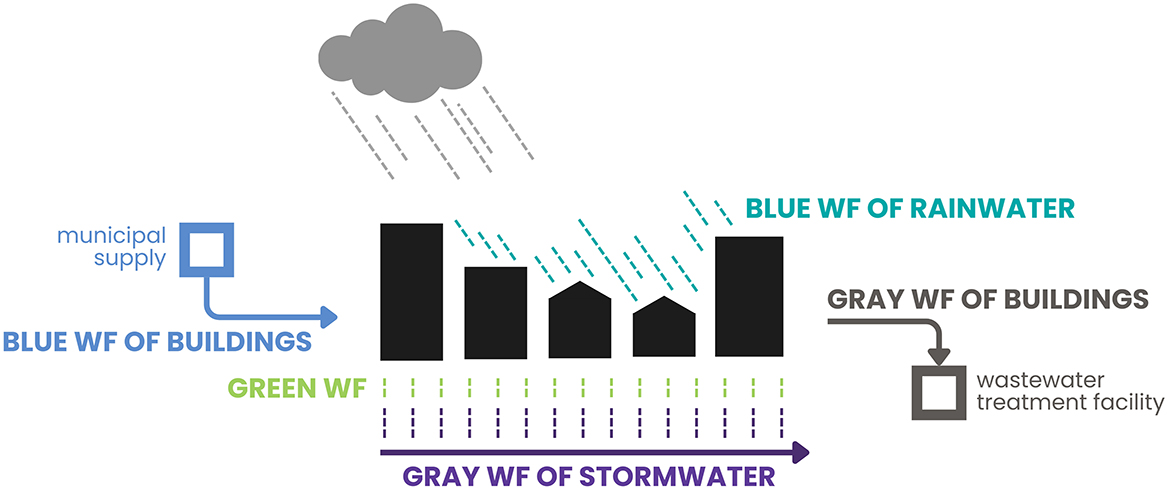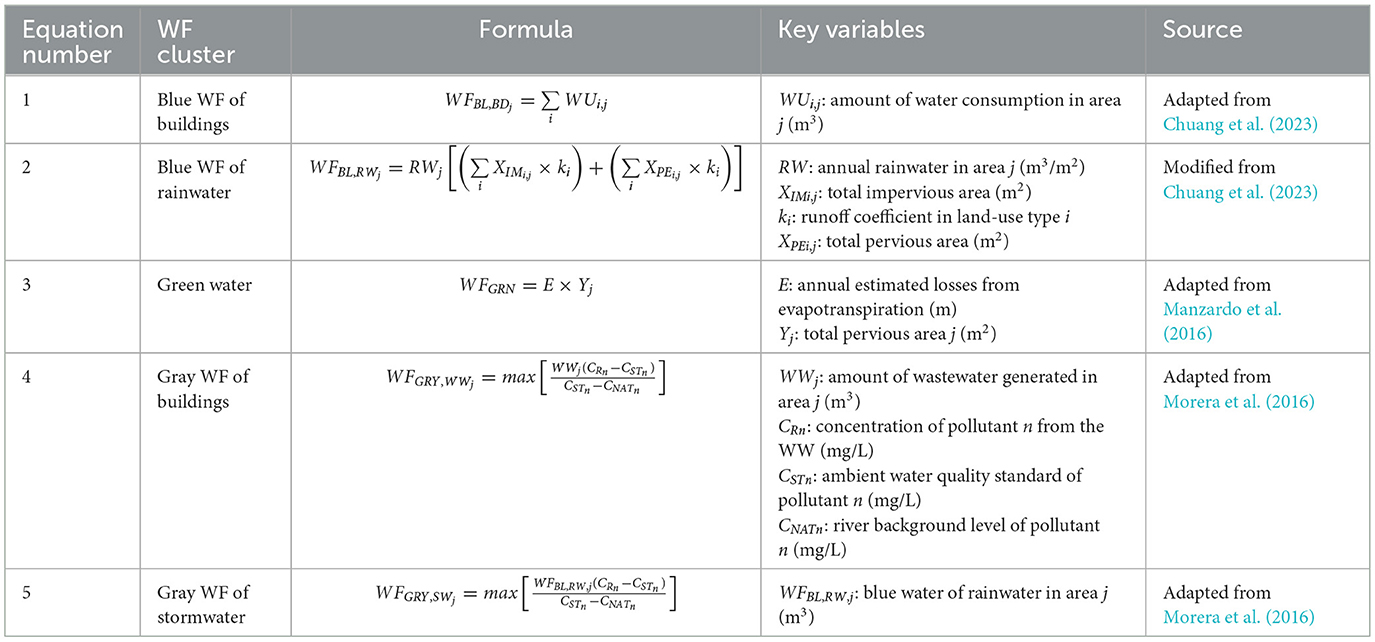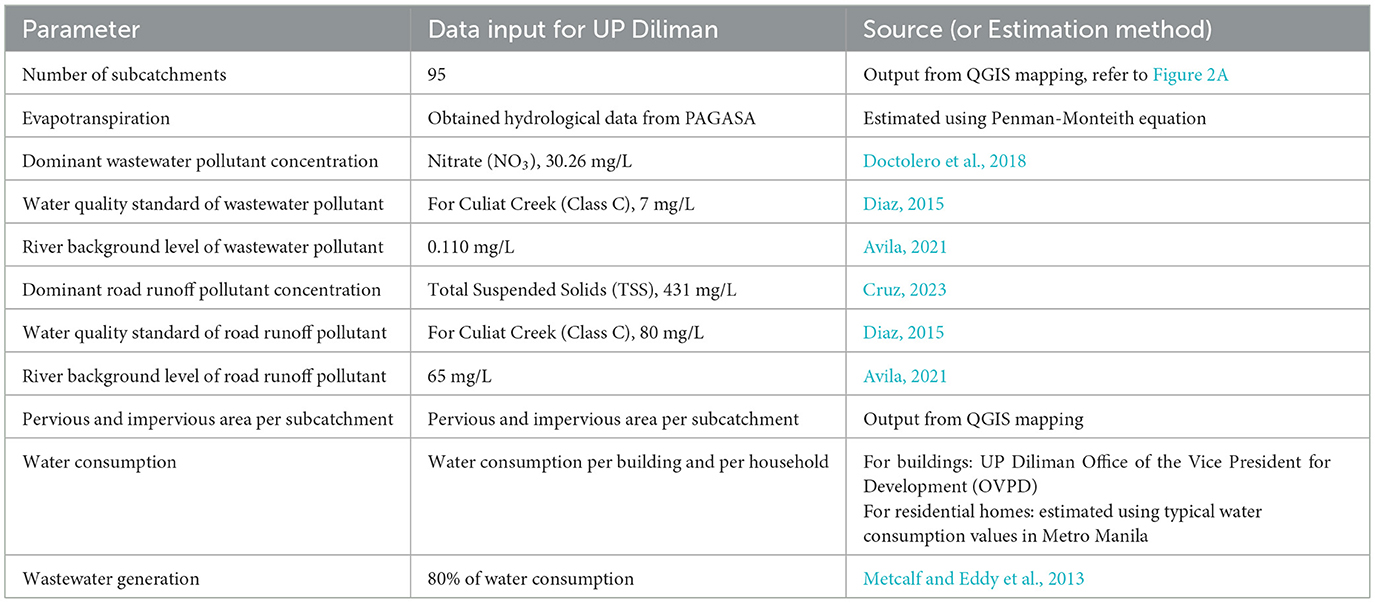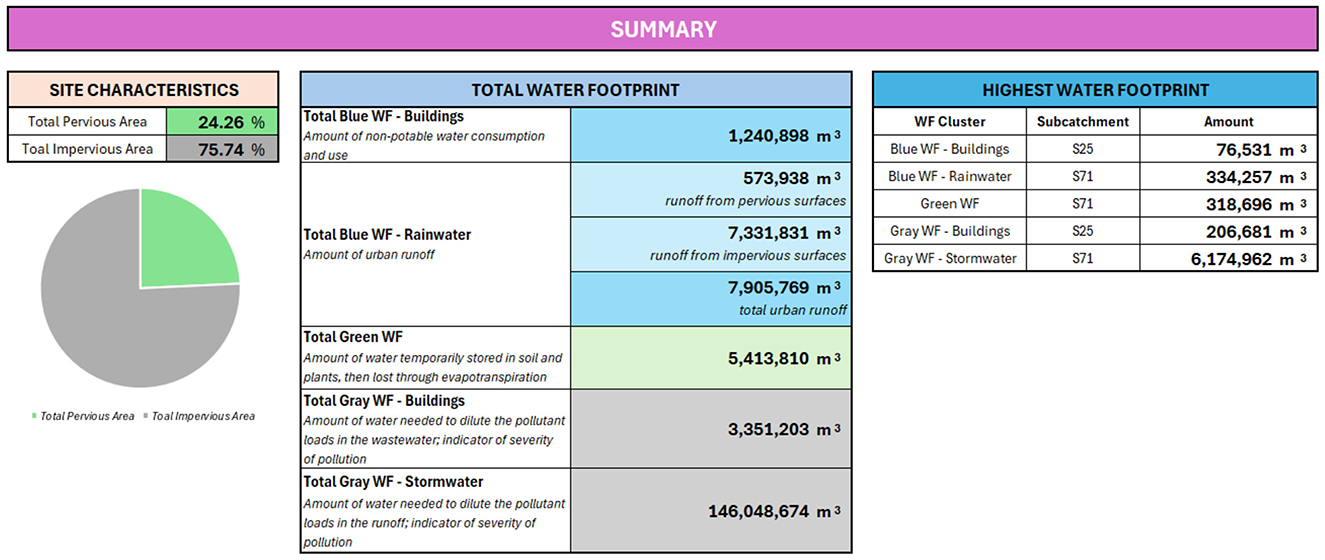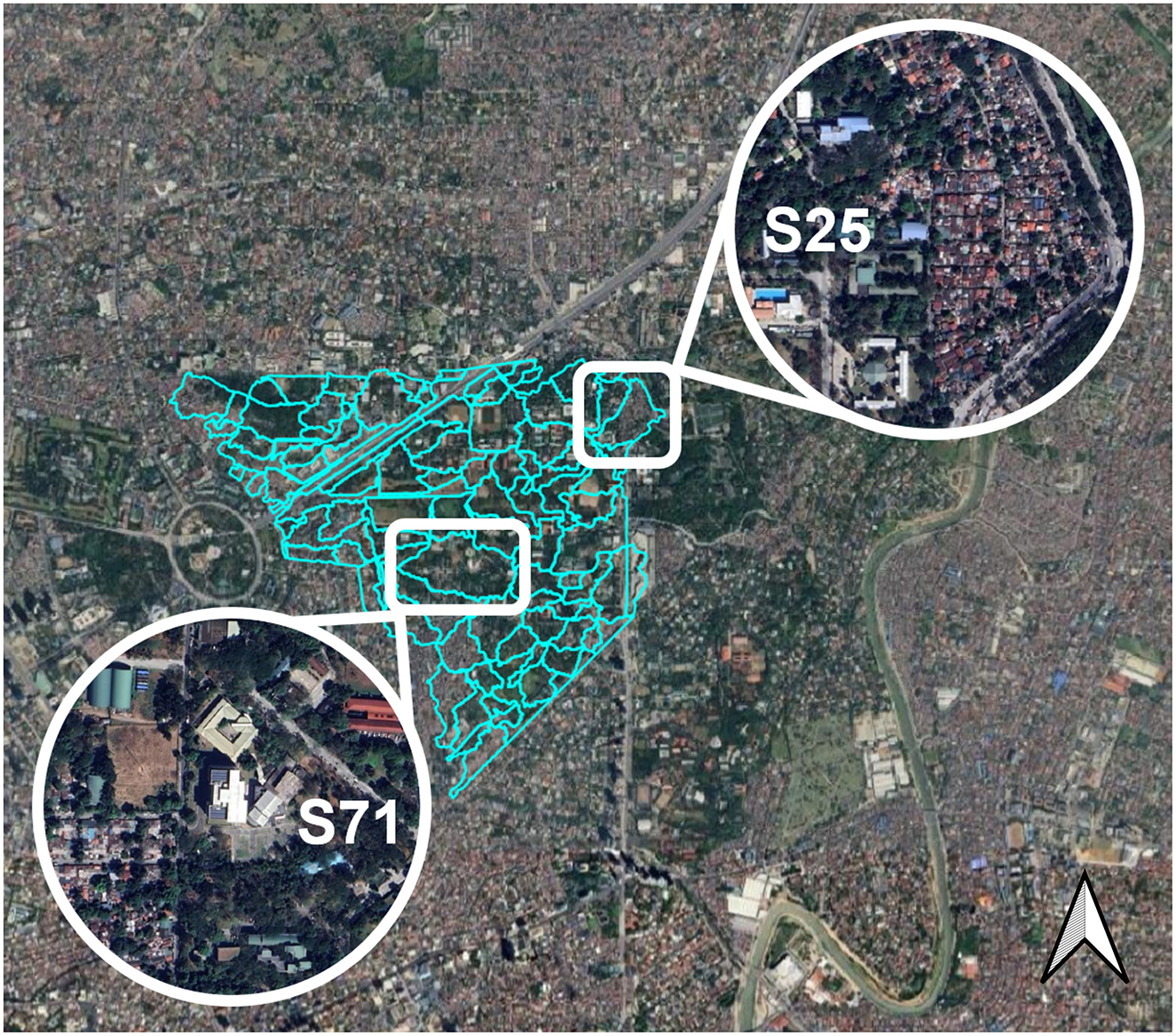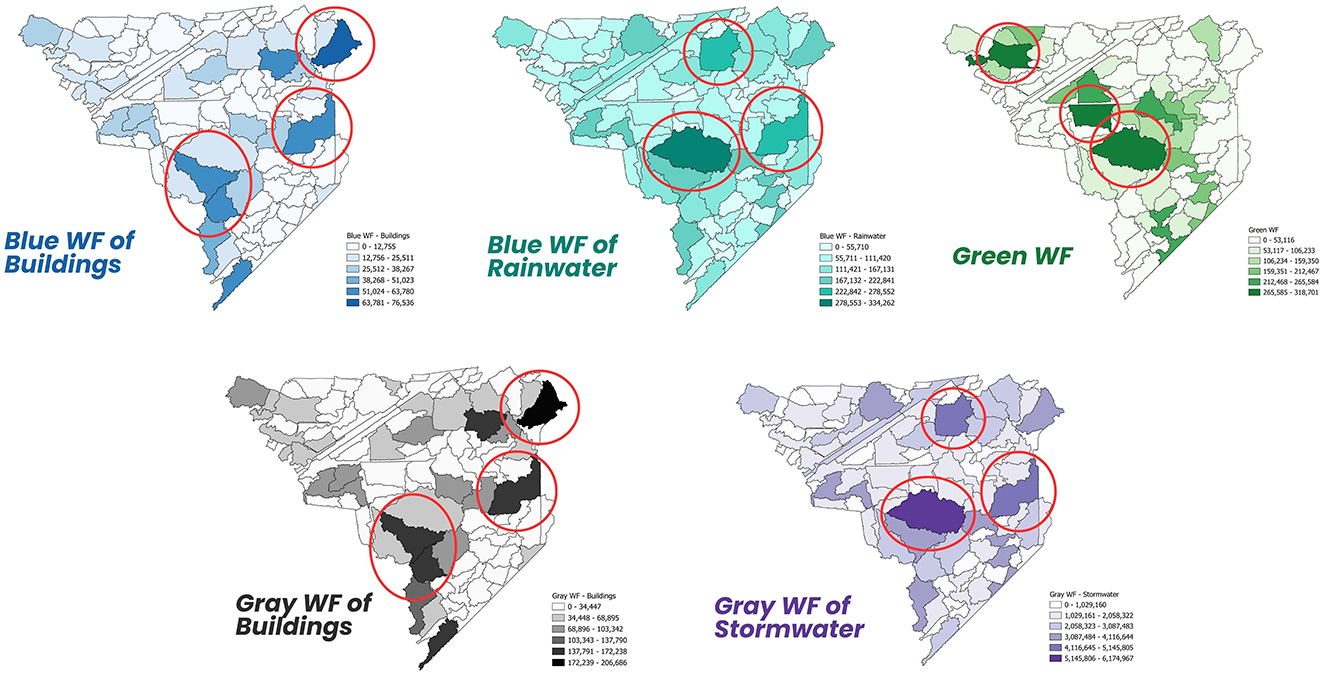- Institute of Civil Engineering, University of the Philippines Diliman, Quezon City, Philippines
Urbanization and climate change significantly worsen water quality and quantity issues, heightening the urgency to address the foregoing concerns in relation to sustainable urban water management. Water Footprint Accounting (WFA) provides a novel and holistic lens for urban water management by quantifying blue, green, and gray water footprints. Unlike conventional assessments that focus only on withdrawals, WFA captures both consumption and pollution, offering a more integrated view of sustainability. This study applies WFA to the University of the Philippines—Diliman campus, using adapted numerical methods from established literature. The approach highlights hidden water dependencies, identifies critical hotspots, and demonstrates the potential of WFA as a decision-support tool for building water-resilient campus. A modified WFA spreadsheet tool was developed to automate the calculation of the blue, green, and gray water, which was then used for UP Diliman. The calculated water footprint (WF) of UP Diliman was mapped, revealing a spatial representation of the WF and WF hotspots. The results revealed that the highest total footprint was the gray water footprint (WF) of stormwater, amounting to 146,048,674 m3/year, primarily associated with suspended solids from eroded ground surfaces during rainfall events. In contrast, the lowest footprint was the blue WF of rainwater at 1,240,989 m3/year. Spatial mapping of water footprints revealed hotspots that serve as indicators of urban characteristics: blue and gray WF hotspots in highly developed areas, and green WF hotspots in zones with significant evapotranspiration. These insights highlight hidden water dependencies, identify critical pressure points, and underscore the need for future developments to integrate water-saving technologies and Low Impact Development (LID) practices. Overall, this study demonstrates how WFA can be applied as an evidence-based decision-support tool for managing and improving urban water systems in mixed land-use settings.
1 Introduction
Urbanization in the Philippines is expected to continuously increase in the coming years. With nearly half of the population already residing in urban areas, managing urban systems has become an escalating challenge. Cities face intensified demands on water supply and sanitation infrastructure, yet conventional drainage networks and centralized water systems are often unsustainable, resulting in excessive runoff and pollutant discharges into receiving water bodies (Barbosa et al., 2012). Traditional drainage systems are also ill-equipped to handle extreme weather events, leading to urban flooding and failure in safely conveying surface runoff (Bibi et al., 2023). Rapid urbanization further alters the natural hydrological cycle by replacing pervious surfaces with impervious ones such as concrete and pavement (City of Edmonton, 2014). In effect, this increases runoff volume while reducing evaporation, transpiration, and groundwater recharge. Added to this is the increased pollutant load from human activity, which is exacerbated by climate change through heavier precipitation and more prolonged storms. These combined pressures highlight the urgency of improving sustainable urban water management strategies, as it is paramount to ensuring water security and environmental sustainability.
Water Footprint Accounting (WFA) is a method that supports the building of water-resilient urban environments. It offers a holistic approach to quantify water use and identify consumption patterns. The concept of Water Footprint (WF) was initially used in an industrial context—defined as the water needed in the production of goods and services (Hoekstra and Chapagain, 2007). WFA has most commonly been employed at national and provincial levels rather than at urban and city-wide scales as urban environments have unique consumption patterns (e.g., wastewater, urban water use, evaporation) that may not be properly taken into account (Paterson et al., 2015). The process of water footprint accounting has evolved through time such that it has extended beyond industrial and agricultural applications.
To obtain a better understanding of how WFA applies to urban contexts, it is helpful to review its core components. WF provides an overview of the general water use and demonstrates how water is consumed in an area. The water footprint has three components: blue, green, and gray water. Blue water refers to the consumption of water sourced from surface and groundwater, green water refers to water temporarily stored in soil, and gray water refers to the volume of water needed to dilute water discharge with pollutant loads to meet water quality standards (Hoekstra et al., 2011; Chuang et al., 2023). In the urban context, the water footprint is much more complicated as the urban water system consists of different water flows, water users, and sources. There remain several limitations in analyzing the urban water footprint, primarily due to the large data requirement, the complexity of the urban water cycle, and the unavailability of real water consumption data on an urban scale (Manzardo et al., 2016). Meanwhile, a recent study in China introduced a novel perspective by integrating carbon and water footprint accounting into the spatial planning of nature-based solutions (NBS). Findings revealed that vegetation-based interventions, such as green roofs and bioretention systems, are particularly favorable for NBS planning due to their enhanced ecological and environmental benefits—most notably in pollutant removal and carbon sequestration (Wang et al., 2024).
To further contextualize WFA for urban areas, this study categorizes the urban WF into five clusters: blue WF of buildings, blue WF of rainwater, green WF, gray WF of buildings, and gray WF of stormwater. The interactions among these clusters are illustrated in Figure 1, adapted from Lazo (2013). Blue WF of buildings refers to water consumption supplied to buildings and households for domestic and industrial use, whereas blue WF of rainwater refers to rainwater that can be harvested and reused. Green WF is water temporarily stored in soil and lost through evapotranspiration. The two gray WF clusters represent the amount of water required to dilute the pollutant loads to meet water quality standards. Specifically, gray WF of buildings refers to wastewater, while gray WF of stormwater pertains to road runoff.
Recent studies have shown the applications of water footprint accounting such as in the implementation of green infrastructure and in the development of technology for water reuse (Paterson et al., 2015). This further highlights the role of water footprint accounting in achieving a more data-driven approach for sustainable urban water management. However, the lack of research on water footprint accounting, especially in the Philippine setting, has made it difficult to fully understand water consumption patterns. With water footprint accounting, the planning and implementation of water use and reuse practices will be better optimized.
This study presents a method on urban WFA by adapting existing WF equations and models. Using these equations, a WFA spreadsheet tool will be generated. The proposed methodology shall be demonstrated in University of the Philippines Diliman, a mixed land use catchment, as a case study area. The purpose of this study is to allow a better understanding of urban water consumption and water use through WFA and ultimately recognize its role in planning for sustainable urban water management. Furthermore, by developing a WFA tool, other mixed land use areas may utilize such an evidence-based approach to managing their urban water systems.
2 Materials and methods
2.1 Study area
The University of the Philippines Diliman (UP Diliman), located in the National Capital Region (NCR), occupies a 493-hectare campus that embodies the complexities of a mixed land-use setting within an urban environment. Its infrastructure encompasses diverse sub-categories—including academic, administrative, residential dormitories, commercial establishments, government offices, and housing—making it a microcosm of a city. Beyond its built environment, UP Diliman is also recognized as one of the remaining green reserves in Metro Manila, with patches of rich biodiversity that coexist amidst the highly urbanized landscape. An important hydrologic feature within the campus is the UP Lagoon, which functions as a constructed wetland and wastewater treatment facility within the academic oval creek system. Following rehabilitation efforts to improve flow management, the lagoon now plays a critical role in stormwater retention and pollutant removal (Doctolero et al., 2018). However, certain academic and administrative buildings still discharge untreated wastewater into the lagoon before it drains into the Diliman Creek system, eventually flowing into Culiat Creek and the San Juan River (Diaz, 2015).
Given its combination of dense urban infrastructure, significant green spaces, and dynamic hydrologic systems, UP Diliman represents a highly relevant case study for examining sustainable water management in mixed land-use urban conditions.
The following datasets for UP Diliman were gathered: rainfall, temperature, windspeed, solar radiation, 1-m resolution Digital Terrain Map (DTM), water consumption of buildings, land cover map, and building footprints. Using the DTM and building footprint data, a total of 95 subcatchments were delineated using the Quantum Geographic Information System (QGIS), which are shown in Figure 2A. Moreover, the land cover map was used to classify pervious and impervious areas, as shown in Figure 2B.
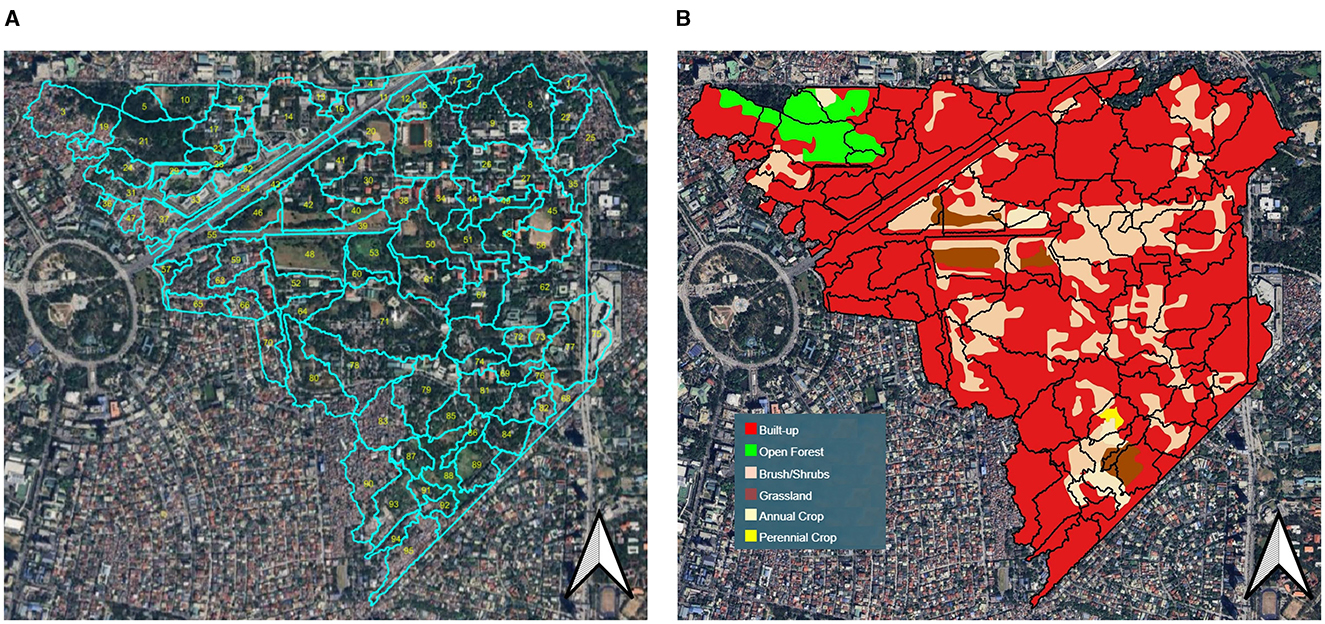
Figure 2. Spatial data outputs for UP Diliman: (A) Subcatchment delineation. (B) Pervious and impervious area classification.
2.2 Water footprint accounting
WFA was performed through numerical analysis. Equations for calculating each WF cluster were adapted from WFA models presented by Chuang et al. (2023), Manzardo et al. (2016), and Morera et al. (2016). Based on these equations, a spreadsheet tool for water footprint accounting was created such that it can be used as a localized WFA tool for mixed land use catchments. This also allows the WFA process to be easily conducted for varying water footprints and adapted for other catchments.
2.2.1 Water footprint accounting equations
Table 1 shows a summary of the WF equations used in the spreadsheet, showing the key variables and source for each.
Equations 1, 3–5 have been adapted from published WF studies, while Equation 2 has been modified from the method used by Chuang et al. (2023). The blue WF of rainwater, WFBL, RW, is primarily derived from the amount of rainfall and land-use type. It is based on the blue water footprint of runoff equation that was first presented by Manzardo et al. (2016) and adapted by Chuang et al. (2023). This equation only considered the runoff on impervious surfaces such as roads and buildings, as shown below:
where WFBL, RFj: annual blue water footprint of runoff in area j (m3)
RW: annual rainwater in area j (m3/m2)
XIMi, j: total impervious area in land-use type i in area j (m2)
ki: runoff coefficient in land-use type i
However, runoff from semi-pervious areas such as lawns and gardens also contribute to urban runoff; hence, it is also necessary to consider its runoff contribution. Runoff from green spaces in urban areas also carries certain pollutants from fertilizers and pesticides, and eventually mixes with the runoff from impervious surfaces. Moreover, it has been renamed from “blue WF of runoff” to “blue WF of rainwater” to highlight how this water footprint cluster is water that can be collected and reused, and theoretically, has yet to flow over land. Equation 2 shows the modified equation, which includes the added runoff contribution of semi-pervious surfaces such as lawns, gardens, and parks.
Equation 3 is based on evapotranspiration, which will be estimated using the Penman-Monteith Method, given by:
where Rn: daily net radiation flux (MJ/m2-d)
G: daily soil heat flux density (MJ/m2-d)
γ: psychrometric constant (kPa/°C)
Cn: numerator constant for the reference crop type and time step
Tmean: daily mean air temperature (°C)
WND2: daily wind speed 2 m above the ground surface (m/s)
es: daily mean vapor pressure of the air at saturation (kPa)
ea: daily mean actual vapor pressure (kPa)
Cd: denominator constant for the reference crop type and time step
Equations 4, 5 observe similar structures, but Equation 4 is based on wastewater generated while Equation 5 is based on stormwater.
2.2.2 Water footprint accounting spreadsheet tool
The WFA tool was developed in the form of an Excel spreadsheet, with water footprint equations implemented as Excel Macros using Visual Basic for Applications (VBA) to simplify and automate calculations of the urban water footprint. The interface was designed to be user-friendly, with dedicated input sheets for data entry (e.g., water use, land cover, rainfall, and pollutant loads) and automated output sheets that generate tabulated results and summary charts of blue, green, and gray water footprints. This structure enables quick scenario analysis and visualization of water footprint patterns across spatial clusters.
2.3 Calculation of water footprint
The WF for UP Diliman was calculated using the WFA spreadsheet tool. Table 2 shows a summary of the necessary data input in the spreadsheet, the data entered for UP Diliman, and their sources.
Calculation of WF was initiated by delineating the subcatchments in the campus using QGIS. All necessary data for the calculation of evapotranspiration (i.e., wind speed, temperature, relative humidity, solar radiation) were obtained from PAGASA. For both the wastewater and road runoff pollutant data, the following data were collected: pollutant concentration of the wastewater or road runoff, ambient water quality standard of the pollutant or the maximum allowable concentration, and the river background level of the pollutant. The wastewater pollutant data was obtained from a study by Doctolero et al. (2018) on the water quality of the UP Diliman lagoon. They assessed primary water quality parameters such as phosphate, nitrate, and ammonia concentrations. Based on these, the pollutant yielding the highest pollutant factor was used as the final input. On the other hand, due to limitations on the road runoff pollutant data specific to UP Diliman, water quality data from a study by Cruz (2023) was used, which assessed road runoff from Balanga City, Bataan—an area with mixed land use in the Philippines. Since Balanga City and UP Diliman have similar land characteristics and are both urbanized areas, it is a suitable secondary source for the purpose of this study.
Data specific for each subcatchment were also inputted, which were the pervious area (m2), impervious area (m2), water consumption (m3/y), and wastewater generation (m3/y). Before entering the water consumption per subcatchment, the specific buildings and number of houses belonging to each subcatchment were first identified. For the buildings, the water consumption values from the provided data of OVPD for the year 2023 were used. For the water consumption of households, they were estimated using the typical water consumption values for NCR and the average number of members per household in the UP Campus. According to the Philippine Institute for Development Studies, an average Metro Manila resident consumes 48 to 108 liters of water per day. Moreover, according to the 2015 census, UP Campus has an average of 4.17 members per household (PhilAtlas, 2015). Based on this, a typical water consumption of 48 L/capita/day was used to avoid overestimation, and an average of 5 members per household. An estimate of the annual water consumption per household was then obtained with a value of 87.6 m3/y. This value was multiplied by the number of households present in each subcatchment to obtain the water consumption contribution of residential houses. Once all data input was completed, the calculation of urban water footprint (m3/year) for 2023 was done automatically by the spreadsheet tool.
3 Results
3.1 Water footprint results
Figure 3 shows a summary of the annual estimates of WF in UP Diliman, generated from the WFA spreadsheet tool. The total water footprint per cluster is presented in the summary table which shows a general overview of the water patterns in UP Diliman. The highest total footprint was the gray WF of stormwater with a value of 146,048,674 m3/year, while the lowest total was the blue WF of rainwater with a value of 1,240,989 m3/year. Gray WF having the highest amount implies the significant percentage of impervious surfaces and the pollutant loads it has on its surface. On the other hand, blue WF of buildings having the lowest value implies that water consumption is noticeably less than the runoff generated or the water lost through evapotranspiration. However, a current limitation is what the values of the total water footprint per cluster specifically represent due to the absence of urban water footprint standards. Hence, these numbers will be better interpreted through a thorough assessment of the subcatchments instead of as a whole.
The highest water footprint per cluster is presented by returning the subcatchment number together with its corresponding values. Among all subcatchments, subcatchment 25 (S25) exhibited the highest blue and gray WF of buildings, which can be attributed to the concentration of houses and residential structures in the area. Meanwhile, subcatchment 71 (S71) recorded the highest blue WF of rainwater, green WF, and gray WF of stormwater, reflecting the combination of built-up areas and open spaces within its boundaries. Figure 4 shows the location of these subcatchments within the study area. These findings illustrate how varying land-use characteristics directly influence water footprint profiles, reinforcing the importance of spatially explicit analysis in guiding sustainable water management strategies.
3.2 Water footprint maps
After WFA, the water footprint was mapped using QGIS. Figure 5 shows the water footprint maps for all WF clusters. Each WF map has six legend entries, each with different colors representing a specific range of water footprint values. Most subcatchments fall under the first legend entry, implying lower water activity and impact in these areas relative to others. Only a select few subcatchments fall within the darker colored legend entries. Moreover, it can be observed that Figures 5A, D have similar spatial patterns, and the same can be seen for Figures 5B, E.
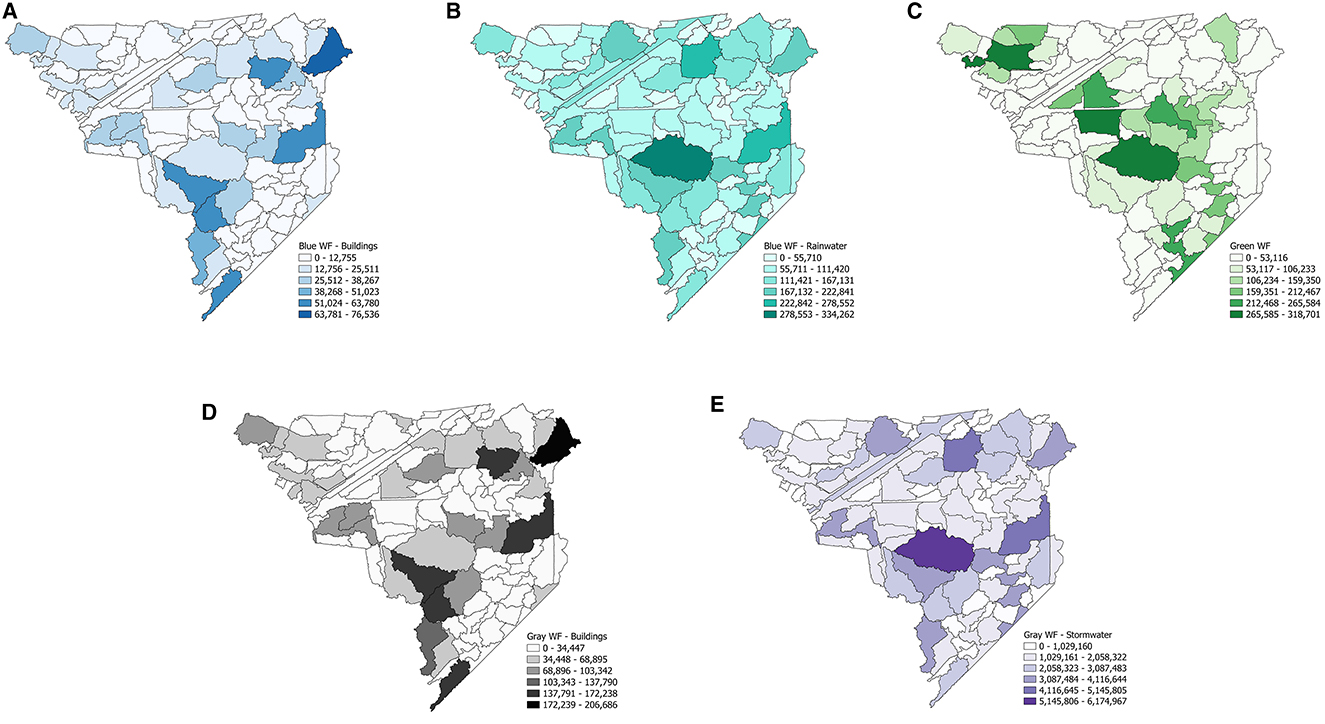
Figure 5. Water footprint maps of UP Diliman: (A) Blue water footprint of buildings. (B) Blue water footprint of rainwater. (C) Green water footprint. (D) Gray water footprint of buildings. (E) Gray water footprint of stormwater.
3.3 Water footprint hotspots
Based on the WFA maps, the water footprint hotspots can easily be identified for each cluster, as illustrated in Figure 6. Some subcatchments are consistently observed to be hotspots across different water footprint clusters, most notably S25 and S71. S25, identified as a blue and gray WF hotspot, is attributed to its proximity to two student dormitories and a dense cluster of houses, resulting in high water demand and consumption. Meanwhile, S71, identified as a hotspot for blue WF of rainwater, green WF, and gray WF of stormwater, reflects the area's mix of undeveloped and developed elements. It encompasses a portion of a residential area, a commercial building, three academic buildings, and a large green area in between these built structures. This unique combination allows S71 to temporarily store water due to green spaces while also generating high runoff volumes from impervious areas. These findings demonstrate how land-use diversity and density directly shape water footprint hotspots, emphasizing the need for targeted management interventions such as water-saving measures in high-demand zones and Low Impact Development (LID) practices in mixed-use areas.
4 Discussion
4.1 Water footprint accounting method
Manzardo et al. (2016) and Fialkiewicz et al. (2018) proposed urban WFA methods that compute the blue, green, and gray water footprints using numerical analysis. Similar to this study, they addressed improving the applicability of WFA in urban areas given that it is complex and resource consuming. Manzardo et al. (2016) introduced a modular approach which uses the concept of “building blocks.” In this method, the type of buildings is separated and assumed that each type has homogeneous characteristics. By further dividing an urban area into smaller-scale boundaries, the differences in water use are better taken into account. This also includes defining the green areas, impervious areas, and other structures that require water use. Since such methodology is still data intensive, Fialkiewicz et al. (2018) aimed to simplify the modular approach by using surface areas in place of building blocks to represent the urban area. This needed less data and relied on information that is more easily obtained.
Both these methods were integrated into the WFA approach presented in this study, specifically in terms of taking into account urban surfaces in WFA and using numerical analysis. However, instead of looking at the water footprint of an urban area as a single unit, this study focused on analyzing the water footprint of subcatchments within the urban area, which were delineated using QGIS. A GIS-based approach delineates subcatchments based on industry or land-use type which enables a more spatially targeted water footprint assessment, aligning with the WF method used by Chuang et al. (2023).
Chuang et al. (2023) also expanded the definition of the blue water footprint for urban areas, introducing the “blue WF of buildings” and the “blue WF of runoff.” This study adapted such expanded definitions to account for the complexity of water processes in mixed land use catchments. The term “blue WF of buildings” retained, defined as the water consumption, while the “blue WF of runoff” is referred to as “blue WF of rainwater” in this study. This concept of expanding WF clusters was also applied to the gray water footprint—introducing the gray WF of buildings and gray WF of stormwater, which are the gray WF counterparts of the blue WF of buildings and blue WF of rainwater, respectively.
Unlike these methods, the approach done in this study introduced a localized approach to calculating the water footprint by integrating select WFA equations into a spreadsheet tool. This not only reduces the complexity of the WFA process, but also addresses the gap on the availability of WFA tools for urban water footprint calculations. Consistent with published methods, applying WFA to a mixed land use catchment reveals information on areas that may need improvement in their water management capacities. The consistent gap observed among published methods that has yet to be addressed is the establishment of WF standards which can be used to interpret WF results.
4.2 Water footprint analysis of UP Diliman
WFA results show the high impervious area coverage of UP Diliman, which may be attributed to the new urban developments that were both completed and currently being done on campus. According to the Land Use Development and Infrastructure Plan of UP Diliman for 2020–2038 (Office of the Vice Chancellor for Planning and Development and Office of the Campus Architect, 2022), the campus grows annually in terms of programs offered and student enrollees. This leads to potential supply vulnerabilities that introduce the need to increase built assets and upgrade spatial components. Since development is inevitable, it is important that these are carefully planned and implemented sustainably to preserve the green spaces within the campus.
The total water footprint is summed per cluster instead of obtaining the overall sum of all WF clusters. They cannot be added to get a representative water footprint for the study site as each cluster represents different uses of water. Consequently, this can be useful in analyzing various dimensions of urban water management. This also highlights the value of having different WF components as it can support decision-makers on investments and policy formation related to water use, consumption, and treatment.
By observing the different WF hotspots, an overview of their characteristics can be obtained. Subcatchments with high blue WF of buildings typically contain a dense concentration of structures, particularly academic and residential buildings. These are areas that have high water consumption, and consequently, have high wastewater generation. Blue WF of buildings is used for different purposes within the campus such as for toilet flushing, sanitation, and groundskeeping. Identified hotspots for this cluster are subcatchments with large-capacity academic buildings, student dormitories, and densely clustered houses which evidently have high water demand.
High blue water footprint of rainwater is attributed to areas that are more developed compared to other subcatchments. Such subcatchments produce a high amount of runoff given the presence of built-up, impervious areas, in particular, academic and residential areas. As observed, impervious surfaces have a higher runoff contribution compared to the pervious surfaces, given that impervious surfaces occupy larger surface areas and have a higher runoff coefficient.
Moreover, subcatchments with high green water footprints are areas with vegetation that actively utilize stored soil moisture and have significant evapotranspiration. Given this, evapotranspiration input data is crucial as it would greatly affect the resulting WF amount. Higher green WF is observed in subcatchments with open areas and vegetation. Knowing the green WF would aid in identifying which areas need to be improved in terms of infiltration capacity.
Gray water footprint hotspots are essentially scaled blue water footprints, multiplied by a pollutant factor derived from the dominant pollutant, implying that blue WF hotspots also indicate gray WF hotspots. High gray WF is observed in dense clusters of academic and residential areas. This would be especially useful in assessing water quality, and ultimately point to the improvement of pollutant removal from stormwater and wastewater.
Overall, in a mixed land-use setting like UP Diliman, water consumption and runoff generation vary significantly depending on the density of structures, building use, and the proportion of open areas. Subcatchments identified as hotspots for multiple WF clusters exhibit overlapping footprints due to the diverse land-use zones they encompass. Academic and residential zones show higher blue and gray WF because of their numerous water-reliant operations and wastewater discharges, while commercial zones display moderate blue and gray WF as their overall consumption is lower compared to residential and academic buildings. Meanwhile, green spaces and open areas contribute to the green WF by temporarily storing water and reducing runoff, unlike impervious surfaces. These findings underscore the importance of tailoring water management strategies to land-use characteristics. For UP Diliman, integrating WFA insights into campus policies could strengthen existing sustainability programs, such as promoting water conservation in dormitories and academic buildings, enforcing stricter wastewater management measures, and expanding green infrastructure to maximize the regulating benefits of open spaces. By aligning water management practices with land-use patterns, the university can better achieve its sustainability and resilience goals.
4.3 Limitations and recommendations
While the analysis of the water footprint and identification of WF hotspots provide valuable insights, there are certain limitations that have been encountered in mapping the pervious and impervious surfaces. It is important to note that this study used the 2020 land cover map in determining the pervious and impervious areas, which is not consistent with most of the other input data that were based on year 2023. Moreover, the land cover map was observed to generalize certain parts of the subcatchment, in particular the built-up areas. It is recommended to utilize satellite imagery which would provide higher accuracy in determining impervious areas, especially in urban catchments, as it is based on user-defined training points that would allow separate classification of buildings, roads, and other impervious elements. Another limitation is the lack of water footprint standards that can be used to easily classify specific areas or subcatchments as water footprint hotspots, which future studies may explore. Water footprint standards also allow a more systematic interpretation and understanding of the calculated water footprint of an area.
Future studies may also focus on different sustainability assessments such as by calculating and comparing the urban water footprint of different areas, assessing the impacts of climate change on the water footprint, and checking for water stress indicators. WFA is still heavily lacking research, especially on a local scale. Furthering the studies on WFA would greatly benefit cities and communities, and by increasing their awareness on the use of WFA, sustainable urban water management and planning would be better achieved.
Given the identified WF hotspots, several strategies can be adopted to improve the hydrologic condition of the campus. In the short term, immediate and low-cost interventions can be pursued. These include the installation of water-saving technologies in building-related blue WF hotspots, such as replacing single-flush toilets with dual-flush systems, which have been shown to significantly reduce municipal water use (Grant et al., 2012). Rainwater harvesting systems can also be installed on structures with large rooftop areas to collect and reuse runoff for various domestic purposes (Chuang et al., 2023). In addition, gray WF hotspots may benefit from the early adoption of bioretention systems and vegetated swales, which can facilitate the treatment of stormwater and road runoff. In the medium term, more structural interventions can be implemented through water-sensitive urban planning and the integration of Low Impact Development (LID) practices. For blue WF of rainwater hotspots, strategies such as sustainable urban drainage systems and LID features—including permeable pavements and rain gardens—can be constructed to reduce runoff and improve infiltration (Fialkiewicz et al., 2018). Green WF hotspots, meanwhile, can be enhanced by introducing infiltration trenches and constructed wetlands, which improve natural water retention and mitigate downstream flooding risks. At this stage, campus planning guidelines may also be revised to incorporate water-sensitive and sustainable design in both new infrastructure projects and retrofits of existing facilities. In the long term, the integration of WFA-based hotspot analysis into campus-wide policies will be essential to sustain progress. This entails institutionalizing water-sensitive design as a standard requirement for infrastructure development and establishing a comprehensive campus water management framework that combines monitoring, modeling, and adaptive planning in line with climate resilience objectives. Over time, UP Diliman campus may also serve as a model for other urban and mixed land-use areas, promoting the wider adoption of best practices such as LID.
5 Conclusion
This study presented a method on urban WFA by adapting existing WF equations and models. A water footprint accounting spreadsheet tool was created to automate the process of water footprint accounting, which would yield the amounts of blue, green, and gray water in a specific urban area. Five different WF clusters have been defined in this study: blue WF of buildings, blue WF of rainwater, green WF, gray WF of buildings, and gray WF of stormwater. The tool was used to calculate the water footprint of UP Diliman and revealed WF hotspots.
Water footprint accounting revealed spatial patterns in water use and consumption, and allowed a more thorough analysis of urban water patterns. The results of WFA for UP Diliman imply the need for future built developments to be carefully planned and implemented through sustainable means to preserve the green areas of the campus. Moreover, the mapped water footprint revealed water footprint hotspots throughout the area. These areas are those whose hydrologic condition may be enhanced through the improvement of urban water systems, implementation of water-saving technologies, or allocation of LID practices. Trends in WF hotspots also show that they are indicators of urban characteristics, such that blue and gray WF hotspots indicate that a certain area is highly developed relative to other areas, while a green WF hotspot imply that evapotranspiration is significant.
The results of this study demonstrate that WFA can serve as a robust, evidence-based approach for managing and improving urban water systems while ensuring sustainability. By quantifying and mapping water footprints across different clusters, WFA provides critical insights into hidden dependencies, consumption patterns, and pollution hotspots. As such, the WFA tool developed in this study offers practical value for local planning offices, particularly in guiding sustainable urban water management within mixed land-use catchments. Its application can inform policy, prioritize interventions, and support the integration of water-sensitive practices into long-term urban development strategies.
Data availability statement
The original contributions presented in the study are included in the article/Supplementary material, further inquiries can be directed to the corresponding author.
Author contributions
CM: Conceptualization, Investigation, Methodology, Software, Visualization, Writing – original draft, Writing – review & editing. GC: Conceptualization, Formal analysis, Project administration, Resources, Supervision, Validation, Visualization, Writing – review & editing. FS: Data curation, Methodology, Software, Supervision, Validation, Visualization, Writing – review & editing.
Funding
The author(s) declare that no financial support was received for the research and/or publication of this article.
Acknowledgments
The authors would like to acknowledge the support and contribution of UP OVPD, DOST-PAGASA, and NAMRIA in the data collection stage of this study.
Conflict of interest
The authors declare that the research was conducted in the absence of any commercial or financial relationships that could be construed as a potential conflict of interest.
Generative AI statement
The author(s) declare that no Gen AI was used in the creation of this manuscript.
Any alternative text (alt text) provided alongside figures in this article has been generated by Frontiers with the support of artificial intelligence and reasonable efforts have been made to ensure accuracy, including review by the authors wherever possible. If you identify any issues, please contact us.
Publisher's note
All claims expressed in this article are solely those of the authors and do not necessarily represent those of their affiliated organizations, or those of the publisher, the editors and the reviewers. Any product that may be evaluated in this article, or claim that may be made by its manufacturer, is not guaranteed or endorsed by the publisher.
Supplementary material
The Supplementary Material for this article can be found online at: https://www.frontiersin.org/articles/10.3389/frwa.2025.1655691/full#supplementary-material
References
Avila, D. K. (2021). San Juan River System Water Quality Management Area. Environmental Management Bureau. Available online at: https://emb.gov.ph/wp-content/uploads/2021/02/SAN-JUAN-RIVER-SYSTEM.pdf (Accessed December 7, 2024).
Barbosa, A. E., Fernandes, J. N., and David, L. M. (2012). Key issues for sustainable urban stormwater management. Water Res. 46, 6787–6798. doi: 10.1016/j.watres.2012.05.029
Bibi, T. S., Reddythta, D., and Kebebew, A. S. (2023). Assessment of the drainage systems performance in response to future scenarios and flood mitigation measures using stormwater management model. City Environ. Interact. 19:100111. doi: 10.1016/j.cacint.2023.100111
Chuang, W.-K., Lin, Z.-E., Lin, T.-C., Lo, S.-L., Chang, C.-L., and Chiueh, P.-T. (2023). Spatial allocation of lid practices with a water footprint approach. Sci. Total Environ 859, 160–201. doi: 10.1016/j.scitotenv.2022.160201
City of Edmonton (2014). Low Impact Development - Best Management Practices Design Guide Edition 1.1. Edmonton, AB: City of Edmonton.
Cruz, G. G. (2023). First flush analysis as an evidence-based method for site-specific design and optimization of low impact development controls for urban stormwater management. Retrieved from: https://animorepository.dlsu.edu.ph/etdd_civ/6
Diaz, A. M. (2015). Water Quality Assessment of the Creek System in the University of the Philippines Academic Oval. Institute of Civil Engineering, University of the Philippines Diliman. Available online at: https://tuklas.up.edu.ph/Record/UP-99796217612579334?sid=36456573
Doctolero, D. D. M., Sta. Maria, A. M., and Diola, M. B. L. D. (2018). Assessment of the water quality of the UP Diliman Lagoon and the Academic Oval creek system. Available online at: https://tuklas.up.edu.ph/Record/UP-99796217612880593
Fialkiewicz, W., Burszta-Adamiak, E., Kolonko-Wiercik, A., Manzardo, A., Loss, A., Mikovits, C., et al. (2018). Simplified direct water footprint model to support urban water management. Water 10:630. doi: 10.3390/w10050630
Grant, S. B., Saphores, J.-D., Feldman, D. L., Hamilton, A. J., Fletcher, T. D., Cook, P. L. M., et al. (2012). Taking the “waste” out of “wastewater” for human water security and ecosystem sustainability. Science 337, 681–686. doi: 10.1126/science.1216852
Hoekstra, A. Y., and Chapagain, A. K. (2007). Water footprints of nations: water use by people as a function of their consumption pattern. Water Resources Manage. 21, 35–48. doi: 10.1007/s11269-006-9039-x
Hoekstra, A. Y., Chapagain, A. K., Aldaya, M. M., and Mekonnen, M. M. (2011). The Water Footprint Assessment Manual: Setting the Global Standard. London: Earthscan.
Lazo, M. O. (2013). Water footprint of coastal tourism facilities in small island developing states: a case-study of a beach resort on the Maldives (Master's thesis). University of British Columbia, Vancouver, BC, Canada.
Manzardo, A., Loss, A., Fialkiewicz, W., Rauch, W., and Scipioni, A. (2016). Methodological proposal to assess the water footprint accounting of direct water use at an urban level: a case study of the municipality of Vicenza. Ecol. Indic. 69, 165–175. doi: 10.1016/j.ecolind.2016.04.016
Metcalf Eddy, Inc., Tchobanoglous, G., Stensel, H. D., Tsuchihashi, R., and Burton, F. L. (2013). Wastewater engineering: Treatment and resource recovery (5th ed.). New York, NY: McGraw-Hill Education.
Morera, S., Corominas, L., Poch, M., Aldaya, M. M., and Comas, J. (2016). Water footprint assessment in wastewater treatment plants. J. Clean. Prod. 112, 4741–4748. doi: 10.1016/j.jclepro.2015.05.102
Office of the Vice Chancellor for Planning and Development and Office of the Campus Architect (2022). University of the Philippines-Diliman Campus Land Use Development and Infrastructure Plan (2020-2038). Quezon City: Office of the Vice Chancellor for Planning and Development and Office of the Campus Architect.
Paterson, W., Rushforth, R., Ruddell, B. L., Konar, M., Ahams, I. C., Gironás, J., et al. (2015). Water footprint of cities: a review and suggestions for future research. Sustainability 7, 8461–8490. doi: 10.3390/su7078461
PhilAtlas (2015). UP Campus. Available online at: https://www.philatlas.com/luzon/ncr/quezon-city/up-campus.html (Accessed December 7, 2024).
Keywords: water footprint accounting, mixed land use catchment, urban water management, water footprint (WF), urbanization
Citation: Maranan C, Cruz G and Santos F (2025) Quantifying blue, green, and gray water footprints in a mixed land use urban catchment for sustainable urban water management. Front. Water 7:1655691. doi: 10.3389/frwa.2025.1655691
Received: 28 June 2025; Accepted: 11 September 2025;
Published: 02 October 2025.
Edited by:
Dyah Hizbaron, Gadjah Mada University, IndonesiaReviewed by:
Ayat-Allah Bouramdane, International University of Rabat, MoroccoTaiane Regina Hoepers, Governo do Estado do Paraná, Brazil
Copyright © 2025 Maranan, Cruz and Santos. This is an open-access article distributed under the terms of the Creative Commons Attribution License (CC BY). The use, distribution or reproduction in other forums is permitted, provided the original author(s) and the copyright owner(s) are credited and that the original publication in this journal is cited, in accordance with accepted academic practice. No use, distribution or reproduction is permitted which does not comply with these terms.
*Correspondence: Gil Cruz, Z2djcnV6anJAdXAuZWR1LnBo
 Czarina Maranan
Czarina Maranan Gil Cruz
Gil Cruz Franz Santos
Franz Santos